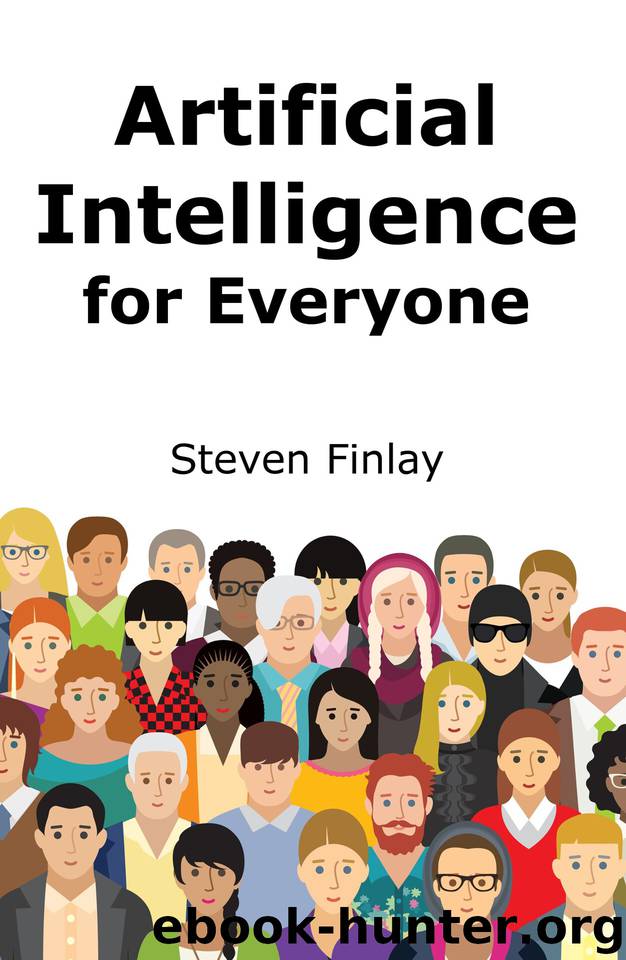Artificial Intelligence for Everyone by Finlay Steven

Author:Finlay, Steven [Finlay, Steven]
Language: eng
Format: epub
Publisher: Relativistic
Published: 2020-01-26T16:00:00+00:00
Artificial intelligence is most effective at supporting the automation of tasks when:
Tasks are well defined. You can understand clearly what’s involved in doing it.
There is lots of data about tasks for the AI to learn from.
There are clear decisions or outcomes that are required, based on the data available for training.
The tasks are frequent and repeatable.
A task is measurable. It’s easy to determine if the task was performed well, or not.
As we discussed in Chapter 2, current artificial intelligence applications tend to be quite narrow in their capabilities. A typical AI app is very good at specific tasks, but not so great when it comes to general intelligence. When it comes to the low hanging fruit, if you work in an industry where lots of people are doing a lot of similar things, or making certain types of decision on a frequent basis, then these are the roles that are most at risk of being impacted. Even if you think that the task you do is very complex or requires a lot of training, that does not reduce your vulnerability. If what you do is something that can be distilled down to a set of clear-cut actions, decisions and outcomes, then your job is at risk.
The more diverse and one-off the type of work, and the broader the span of someone’s responsibilities, the harder it is to develop an AI-based tool to perform that role effectively. That’s not to say that an AI won’t be developed that can do that role at some point in the future but that it’s not feasible now or it can be done now, but the cost is prohibitively expensive, making it not cost effective to replace you yet.
Arguably, there are also some types of job where only a person will do because, it is argued, we like personal interaction and value the human touch more highly than having something that is ruthlessly efficient. Maybe a robot could technically do the role, but we want to keep that 1:1 interaction with a real person. Personally, I like being served in my local pub by a real person. I don’t want a machine to pull a pint for me. Maybe we’ll start seeing “Real bar staff” signs to entice customers into establishments alongside signs advertising real ale and craft beers. I’m also happy for my lawyer to have artificial intelligence tools to help them give me the best legal advice, but I still want them to give me the advice. I don’t want to be talking to a machine. In education, the 1:1 (and 1:many) experience is hard to replace. There are educational robots around that can interact with students to support their education, by asking and answering questions, but they are very crude devices. They are nowhere near being anything like a human teacher and probably won’t be for many years to come, if ever.
Others may feel differently about personal interaction. A lot of people don’t want that 1:1 experience. In fact, for many mundane
Download
This site does not store any files on its server. We only index and link to content provided by other sites. Please contact the content providers to delete copyright contents if any and email us, we'll remove relevant links or contents immediately.
| Computer Vision & Pattern Recognition | Expert Systems |
| Intelligence & Semantics | Machine Theory |
| Natural Language Processing | Neural Networks |
Algorithms of the Intelligent Web by Haralambos Marmanis;Dmitry Babenko(8519)
Test-Driven Development with Java by Alan Mellor(7354)
Data Augmentation with Python by Duc Haba(7253)
Principles of Data Fabric by Sonia Mezzetta(6997)
Learn Blender Simulations the Right Way by Stephen Pearson(6934)
Microservices with Spring Boot 3 and Spring Cloud by Magnus Larsson(6765)
RPA Solution Architect's Handbook by Sachin Sahgal(6170)
Hadoop in Practice by Alex Holmes(6028)
The Infinite Retina by Robert Scoble Irena Cronin(5870)
Jquery UI in Action : Master the concepts Of Jquery UI: A Step By Step Approach by ANMOL GOYAL(5869)
Big Data Analysis with Python by Ivan Marin(5694)
Life 3.0: Being Human in the Age of Artificial Intelligence by Tegmark Max(5398)
Pretrain Vision and Large Language Models in Python by Emily Webber(4654)
Infrastructure as Code for Beginners by Russ McKendrick(4439)
WordPress Plugin Development Cookbook by Yannick Lefebvre(4168)
Functional Programming in JavaScript by Mantyla Dan(4121)
The Age of Surveillance Capitalism by Shoshana Zuboff(4111)
Embracing Microservices Design by Ovais Mehboob Ahmed Khan Nabil Siddiqui and Timothy Oleson(3959)
Applied Machine Learning for Healthcare and Life Sciences Using AWS by Ujjwal Ratan(3931)
